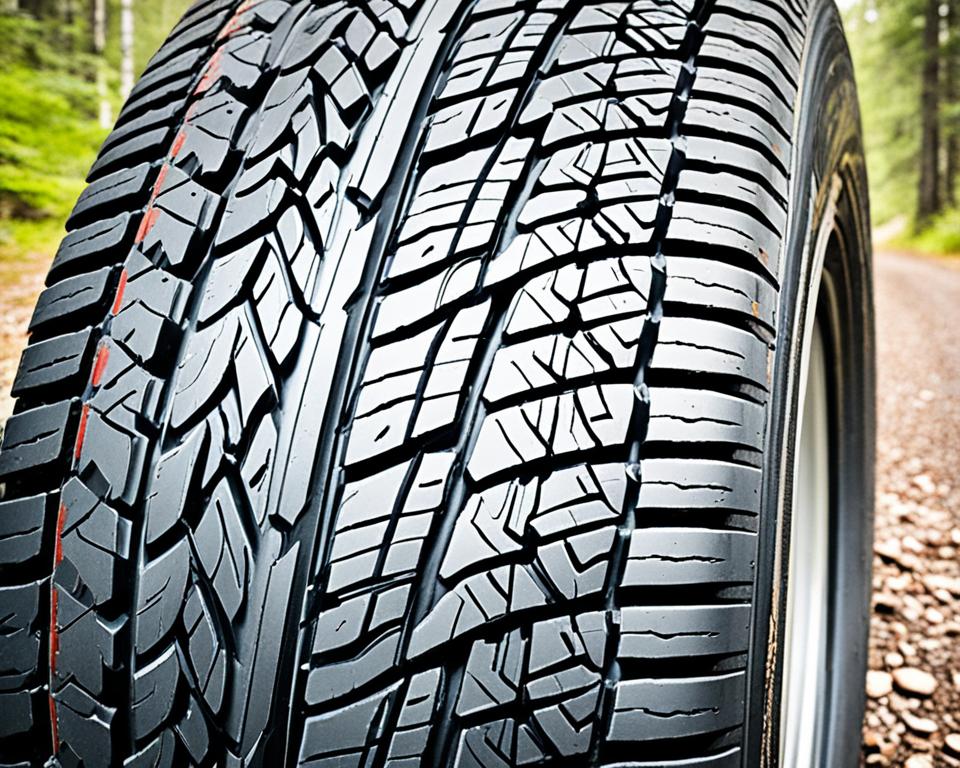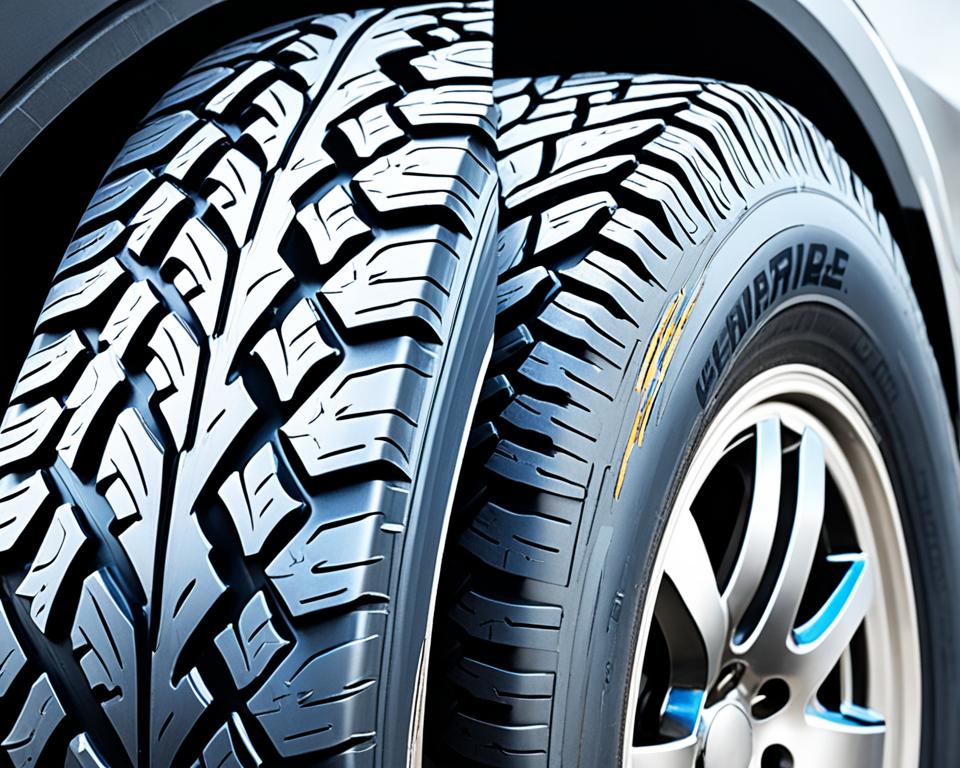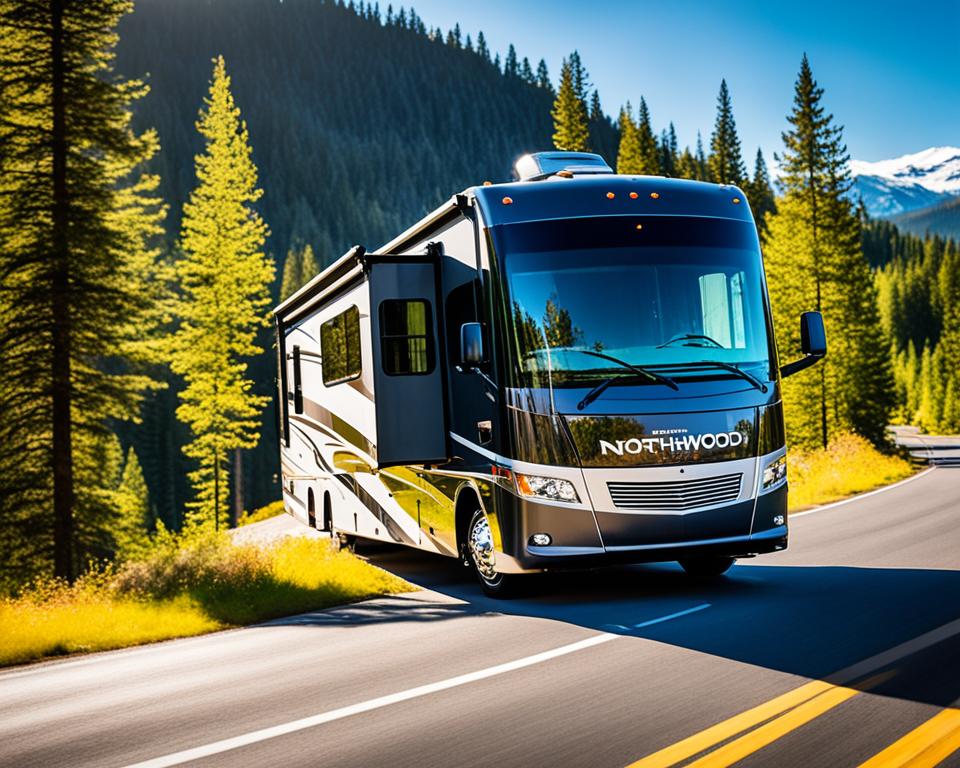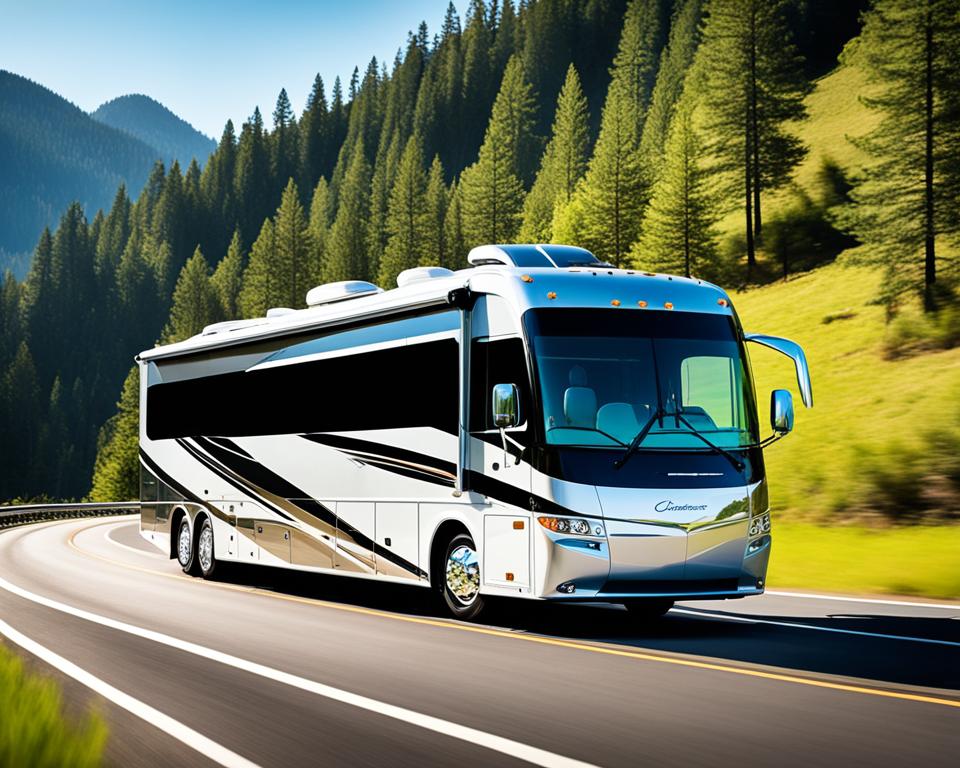Your RV’s tires are an essential component in ensuring the safety and performance of your motorhome. Knowing when it’s time to replace them is crucial for maintaining a reliable and secure vehicle. There are several factors to consider when determining the lifespan of RV tires, including damage, wear, and age.
Signs of tire damage, such as bulges, cuts, debris lodged in the tread, and irregularities, indicate that it’s time for a replacement. Dry rot, caused by excessive sun exposure and low inflation, is another indicator that your tires need attention. The average life expectancy of motorhome tires is between five to seven years, so the age of the tires plays a significant role in determining when they should be replaced. Additionally, wear and tread depth are crucial factors to consider. Uneven wear or worn-down treads indicate the need for new tires to maintain optimal safety on the road.
By regularly checking tire pressure, rotating and balancing tires, practicing safe driving habits, and avoiding tire overload, you can ensure the integrity of your RV tires and enjoy worry-free travels.
Key Takeaways:
- Signs of tire damage, such as bulges, cuts, debris, and irregularities, indicate the need for tire replacement.
- Dry rot, caused by excessive sun exposure and low inflation, is another indication that tires need attention.
- The average life expectancy of RV tires is between five to seven years, with age serving as an important consideration.
- Wear and tread depth play a significant role in determining when tires should be replaced.
- Regular tire maintenance practices, such as checking pressure, rotating, and balancing, are essential for ensuring tire integrity and safety.
Signs of RV Tire Damage
Knowing the signs of RV tire damage is crucial for maintaining the safety and reliability of your motorhome. Regularly checking your tires for any signs of damage can help you identify potential issues early on and prevent accidents on the road.
Here are some common signs of RV tire damage to watch out for:
- Bulges in RV tires: Bulges on the tire sidewall or tread indicate structural weakness and potential tire failure. These bulges may be caused by impact damage or internal tire issues.
- Cuts in RV tires: Cuts or gashes on the tire tread or sidewall can compromise the integrity of the tire and increase the risk of blowouts. Sharp objects on the road or contact with curbs can cause these cuts.
- Debris in RV tire tread: Inspect the tire tread for any lodged debris such as stones, nails, or other foreign objects. These objects can cause punctures or imbalance in the tire.
- Irregularities in RV tires: If you notice any abnormal wear patterns, uneven tire wear, or changes in tire performance, it could be a sign of underlying issues. Misalignment, improper inflation, or suspension problems can contribute to these irregularities.
Remember, it’s important to check all your tires, including the inside duals, as damage may not be immediately apparent. Regular inspections can help you identify and address tire issues before they worsen, ensuring the safety of your RV and its occupants.
“Inspecting your RV tires for signs of damage is crucial for preventing accidents and maintaining your safety on the road.”
“Regular inspections can help you identify and address tire issues before they worsen, ensuring the safety of your RV and its occupants.”
To combat dry rot, a form of tire damage caused by excessive sun exposure, heat, and low inflation, be sure to clean your tires before storage and use tire covers to protect them from the elements.
Take a look at the image below to see an example of RV tire damage:
| https://www.youtube.com/watch?v=X7scHIvjyBk |
Regular tire inspections are essential for maintaining the safety and longevity of your RV tires. By staying vigilant and addressing any signs of damage promptly, you can enjoy worry-free travels and peace of mind on the road.
Age Considerations for RV Tires
When it comes to the age of your RV tires, there are a few important factors to consider. The average life expectancy of motorhome tires is typically between five to seven years. However, it’s crucial to understand that tires can age faster if they are not used regularly. Even if your RV tires have only been used for a few trips over the past 5-7 years, they may still be considered “aged out” and should be replaced. Aging tires tend to become dry, brittle, and more prone to damage, compromising both their performance and safety. To prioritize your safety and ensure the longevity of your RV, it is recommended to replace aged tires.
Regularly inspecting the age of your RV tires is vital for maintaining safe travels. Aging tires can be a serious risk on the road, leading to blowouts and potential accidents. To ensure optimal tire performance, it’s important to replace aged RV tires within the appropriate timeframe.
Motorhome Tire Life Expectancy
Understanding the life expectancy of motorhome tires is essential for proper maintenance and replacement. While the average lifespan is five to seven years, it’s essential to consider other factors that can affect tire wear and aging. These factors include the frequency of use, regular maintenance, storage conditions, and exposure to harsh weather conditions, such as extreme heat or cold.
By knowing the general lifespan of RV tires and considering these additional factors, you can make informed decisions regarding tire replacement and ensure your safety on the road.
Replacing Aged RV Tires
Replacing aged RV tires is crucial for maintaining the safety and performance of your motorhome. Even if your tires appear to be in good condition, age-related wear and tear can compromise their integrity. To determine when it’s time for replacement, refer to the manufacturer’s recommendations and consider factors such as the age of the tires and their usage history.
Investing in new tires not only enhances your safety but also provides peace of mind during your travels. Don’t compromise the quality and reliability of your RV tires by neglecting to replace them when they reach their recommended lifespan.
| Age of RV Tires | Recommendation |
|---|---|
| Below 5 years | Tires are within an acceptable lifespan, but regular inspections are still important. |
| 5-7 years | Tires are aged out and should be replaced to ensure optimal safety and performance. |
| Beyond 7 years | Tires are significantly aged and should be replaced immediately to avoid potential hazards on the road. |
Understanding RV Tire Wear
Monitoring RV tire wear is crucial for ensuring the safety and performance of your motorhome. By regularly examining tire wear and tread depth, you can determine when it’s time to replace your tires and avoid potential hazards on the road.
Signs of tire wear in motorhomes can include uneven tread patterns, loss of tread depth, and visible damage. If your tires are not yet five years old but show signs of wear, it may be time to consider a replacement. Uneven wear and loss of tread can create hazardous driving conditions, increasing the risk of accidents.
Checking the tread depth is an important part of assessing tire wear. The minimum tread depth to replace RV tires is 4/32nd in the front and 2/32nd in the rear. However, most RV owners choose to replace their tires sooner due to the weight and cost of their vehicles. Adequate tread depth ensures proper traction and stability, especially in wet or slippery conditions.
Regularly examining tire wear and tread depth is essential for maintaining safe and reliable tires. It is recommended to perform visual inspections before and after each trip, as well as monthly checks to monitor wear patterns.
To help you understand the importance of monitoring RV tire wear, here is an example of a table showcasing common signs of tire wear:
| Signs of Tire Wear | Description |
|---|---|
| Uneven tread wear | Worn down tread in certain areas, indicating alignment or suspension issues |
| Cupping | Irregular wear with raised or lowered patches on the tread, caused by imbalanced suspension or tire rotation |
| Feathering | Sloping or angled wear on the tread blocks, caused by misalignment |
| Flat spotting | Localized flatness on the tread caused by tire skidding or prolonged parking |
| Bulges or bubbles | Visible bulges or bubbles on the sidewall, indicating internal damage or weak spots |
Understanding these signs of tire wear allows you to take appropriate action, such as getting a wheel alignment, rotating your tires, or replacing them when necessary. Regular maintenance and vigilance in monitoring tire wear will help ensure a safe and enjoyable RV journey.

Factors That Contribute to RV Tire Blowouts
RV tire blowouts can be dangerous and lead to accidents. Several factors contribute to tire blowouts in motorhomes, including:
- Poorly Made or Aged Tires: Low-quality or worn-out tires are more prone to blowouts. It is crucial to invest in reliable tires from reputable brands to reduce the risk.
- Underinflation: When RV tires are underinflated, it creates excessive heat buildup, weakening the tire’s structure and increasing the chances of a blowout. Regularly checking and maintaining proper tire pressure is essential.
- Overloading: Overloading your motorhome puts excessive weight on the tires, which can lead to tire blowouts. Make sure to follow weight limits and distribute the load evenly.
- Excessive Heat: Hot weather or prolonged driving can cause the tire temperature to rise, increasing the risk of a blowout. Avoid driving on extremely hot days or for extended periods without proper breaks.
- Unseen Tire Damage: Damage to the tires, such as cuts, bulges, or internal wear, can weaken the tire structure and eventually result in a blowout. Regular inspections by professionals can help detect hidden tire damage.
- Uneven Weight Distribution: Poor weight distribution in your motorhome can put extra strain on specific tires, leading to uneven wear and an increased potential for blowouts. Properly distribute the weight inside your RV to maintain balanced tire pressure and minimize the risk.
To prevent RV tire blowouts, it is crucial to follow proper tire maintenance practices:
- Regularly inspect and service your RV tires, looking for signs of damage, adequate tread depth, and proper inflation.
- Follow a tire maintenance schedule and have your tires professionally inspected and serviced at recommended intervals.
- Maintain proper tire pressure according to the manufacturer’s recommendations.
- Rotate and balance your RV tires regularly to ensure even wear and optimal performance.
- Adopt safe driving habits, such as avoiding potholes and road debris, and observing speed limits to minimize tire stress.
By taking these proactive measures, you can minimize the risk of RV tire blowouts and ensure a safe and enjoyable journey.
The Importance of RV Tire Maintenance
Regular maintenance is crucial for keeping your RV tires in the best possible condition. By taking the time to perform routine checks and following safe driving practices, you can ensure the longevity and safety of your tires. Here are some key aspects of RV tire maintenance:
Checking RV Tire Pressure
Proper tire pressure is essential for optimal performance and safety on the road. Before every trip, use a tire pressure gauge or consult a professional to check the air pressure in your RV tires. Keeping them properly inflated helps prevent uneven wear, improves fuel efficiency, and reduces the risk of tire blowouts.
Rotating and Balancing RV Tires
Regularly rotating and balancing your RV tires helps promote even tread wear, extending their lifespan and improving overall performance. This process involves moving tires to different positions on the vehicle to distribute the weight and pressure evenly. Consult your RV owner’s manual or a professional to determine the recommended rotation and balancing intervals for your specific setup.
Maintaining Safe Driving Habits
Practicing safe driving habits is crucial for preserving the integrity of your RV tires. Avoiding potholes, road debris, and rough terrains helps prevent tire damage. Additionally, driving at reasonable speeds and refraining from sudden acceleration or braking minimizes stress on the tires, reducing the risk of blowouts or other tire-related issues.
Avoiding Tire Overload
Overloading your RV tires can lead to premature wear and tear, jeopardizing their performance and safety. Be mindful of the weight rating specified for your tires and avoid exceeding it. Distribute the load evenly and consider offloading unnecessary items before hitting the road. Regularly check and adjust the inflation pressure based on the weight carried by your RV.
By prioritizing these maintenance tasks, you can ensure your RV tires are in top condition, providing a safe and enjoyable journey. Remember to follow a comprehensive maintenance schedule and consult professionals when needed.
RV Tire Maintenance Checklist
| Task | Frequency |
|---|---|
| Check tire pressure | Before every trip |
| Rotate and balance tires | As recommended in owner’s manual |
| Inspect tires for damage | Monthly |
| Clean tires and remove debris | Regularly as needed |
| Monitor tread wear | Monthly |
| Avoid tire overload | Ongoing |
Proper Storage and Care for RV Tires
Properly storing and caring for your RV tires during periods of non-use is crucial for ensuring their longevity. By following these guidelines, you can protect your tires from damage and deterioration, ultimately prolonging their lifespan:
- Choose the right storage location: Store your RV tires in a dry and cool area to prevent cracking, dry rot, and deterioration. Direct sunlight can cause damage, so it’s important to keep them away from harsh UV rays. Consider storing them in a covered area or using a garage or storage unit.
- Protect your tires from sunlight: To shield your RV tires from sun exposure, use protective tire covers. These covers act as a barrier against UV rays and slow down damage caused by sunlight. They are especially beneficial during extended periods of storage when your RV is not in use.
- Check tire pressure during storage: Regularly inspect and maintain proper tire pressure while your RV is in storage. Changes in temperature, especially during colder months, can cause pressure to fluctuate. By checking the pressure and adding air if necessary, you ensure that the tires stay in optimal condition while not in use.
Proper storage and care practices are crucial for preventing damage and deterioration of RV tires. By following these guidelines, you can ensure that your tires are well-preserved and ready to hit the road when you’re ready for your next adventure.
Choosing the Right RV Tires
When it comes to choosing RV tires, making the right decision is crucial for ensuring optimal performance and safety on the road. There are several factors to consider in order to select the perfect set of tires that meets your specific needs. Let’s explore the key considerations: tire type, weight rating, and size.
Firstly, you’ll need to decide between two types of RV tires: radial and bias. Radial tires are designed with rubber-coated steel cables, offering a smoother ride and improved fuel efficiency, making them ideal for long-distance travel. On the other hand, bias tires feature strong sidewalls that can handle heavier loads and are better suited for off-road adventures.
Another important consideration is the weight rating of the tires. This rating determines the maximum load capacity a tire can safely support. RV owners should consult their owner’s manual to find the recommended weight rating based on the vehicle’s size, weight, and speed ratings. It’s crucial to choose tires that can handle the weight of your RV and all its belongings to ensure a safe and worry-free journey.
Lastly, determining the right size of tires for your RV is essential. The size of a tire is indicated by a series of numbers and letters on the sidewall. The proper size is determined by the manufacturer based on the specific vehicle model. Selecting the correct tire size ensures proper fitment, optimal handling, and avoids any potential clearance issues.
By taking these factors into consideration when selecting your RV tires, you can ensure that you make an informed decision that prioritizes safety and performance. Now, let’s take a look at a comparison table to summarize the differences between radial and bias tires:
| Tire Type | Advantages |
|---|---|
| Radial Tires | – Provides a softer ride – Better fuel efficiency – Suitable for long-distance travel |
| Bias Tires | – Strong sidewalls handle heavier loads – Ideal for off-road conditions |
Remember, choosing the right RV tires based on type, weight rating, and size is crucial for maintaining safety and ensuring a smooth and enjoyable journey. Now that you have a better understanding of the factors involved, you can confidently make an informed decision when it’s time to replace your RV tires.
Understanding RV Tire Composition
Understanding the composition of RV tires is essential when selecting the right ones and assessing their lifespan. Two common types of RV tires are radial-ply and bias-ply tires, each with its own characteristics and advantages.
Radial-ply Tires:
Radial-ply tires are designed with cords that run perpendicular to the direction of travel. This construction provides several benefits, including a smoother ride and improved handling. The sidewalls of radial-ply tires are more flexible, allowing them to better absorb shocks and bumps on the road. The result is enhanced comfort and reduced vibrations during your RV travels. Additionally, radial-ply tires have a longer lifespan compared to bias-ply tires.
Bias-ply Tires:
Bias-ply tires have cords that run at an angle towards the direction of travel. This construction makes the sidewalls stiffer, offering better resistance to punctures or impacts. Bias-ply tires are commonly used in heavy-duty applications, as they can handle higher loads and are more suitable for off-road conditions. However, they generally have a shorter lifespan compared to radial-ply tires.
By understanding the differences in composition between radial-ply and bias-ply tires, you can make an informed decision when selecting RV tires. Consider factors such as the type of RV travel you engage in, the expected load-bearing capacity, and your preference for ride comfort and longevity.
Now, let’s take a closer look at a comparison table highlighting the key differences between radial-ply and bias-ply tires:
| Aspect | Radial-ply Tires | Bias-ply Tires |
|---|---|---|
| Ride Comfort | Provide a smoother ride with reduced vibrations | Offer stiffer sidewalls, which may result in a slightly rougher ride |
| Handling | Improved handling due to flexible sidewalls | Suitable for heavy-duty applications and off-road conditions |
| Lifespan | Longer lifespan compared to bias-ply tires | Shorter lifespan |
| Load-bearing Capacity | May have lower load-bearing capacity compared to bias-ply tires | Can handle higher loads |
A comparison of the composition and characteristics of radial-ply and bias-ply tires.
Proper Tire Maintenance for Extended RV Trips
When planning extended RV trips, it’s important to prioritize tire maintenance to ensure a safe and enjoyable journey. Taking preemptive measures, such as replacing your tires before the trip, can provide peace of mind and prevent potential issues or tire changes in unfamiliar locations. By putting safety first, you can have uninterrupted travel and focus on the adventures ahead.
To maintain the integrity of your RV tires, it’s recommended to regularly check them throughout the year, not just during camping season. This ongoing maintenance helps identify any potential issues and allows you to address them before hitting the road. Tire pressure should be checked either professionally or with a gauge to ensure optimal performance. Remember, properly inflated tires provide better handling and fuel efficiency.
In addition to checking tire pressure, it’s essential to rotate and balance your RV tires. This helps slow down tread wear and prevents uneven wear patterns, ensuring a smooth and safe ride. By evenly distributing the forces acting on the tires, you can extend their longevity and maintain their performance.
Safe driving habits are also key to preserving the life of your RV tires. Avoiding potholes, road debris, and driving on underinflated tires can help prevent tire damage and potential blowouts. By staying alert and practicing defensive driving techniques, you reduce the risk of accidents and ensure the safety of yourself, your passengers, and your motorhome.
Lastly, it’s important to avoid tire overload, as exceeding the weight rating of your tires can lead to premature wear and potentially cause a blowout. Before embarking on your trip, carefully consider the weight of your belongings and distribute them evenly throughout the RV. By keeping your load within the recommended capacity, you can maintain the integrity of your tires and travel with peace of mind.
Remember, proper tire maintenance is crucial for ensuring safe and enjoyable extended RV trips. By taking the necessary precautions, such as checking tire pressure, rotating and balancing tires, practicing safe driving habits, and avoiding tire overload, you can confidently embark on your adventures and create lasting memories.
Table: RV Tire Maintenance ChecklistMaintenance TaskFrequencyCheck tire pressureBefore each tripRotate and balance tiresEvery 5,000 miles or as recommended by the manufacturerInspect tires for damageRegularly, throughout the yearAvoid tire overloadBefore each trip, considering the weight rating of the tiresPractice safe driving habitsAlways
–><!–
Maintenance Task Frequency
- Checking tire pressure before each trip ensures that the tires are properly inflated for optimal performance and safety.
- Rotating and balancing tires every 5,000 miles, or as recommended by the manufacturer, helps slow down tread wear and prevents uneven wear patterns.
- Regularly inspecting tires for damage throughout the year allows you to identify any issues and address them before they become a safety hazard.
- Avoiding tire overload by considering the weight rating of the tires before each trip helps prevent premature wear and potential blowouts.
- Practicing safe driving habits, such as avoiding potholes and road debris and not driving on underinflated tires, is essential for preserving the life of your RV tires.
–>
Conclusion
Regularly assessing the condition of your RV tires and replacing them when necessary is crucial for ensuring safety and optimal performance on the road. Factors such as tire damage, wear, and age should be considered when determining the lifespan of RV tires.
Proper tire maintenance, including regular inspections, rotations, and maintenance of appropriate tire pressure, can help extend their life. Choosing the right RV tires based on type, weight rating, and size is essential. Additionally, proper storage and care practices can prevent damage and deterioration. By prioritizing tire safety and maintenance, you can enjoy worry-free RV adventures.
FAQ
How often should RV tires be replaced?
RV tires should be replaced based on factors such as damage, wear, and age. It is generally recommended to replace RV tires every five to seven years.
What are the signs of RV tire damage?
Signs of RV tire damage include bulges, cuts, debris lodged in the tread, and irregularities. Dry rot, caused by excessive sun exposure and low inflation, is another indicator that tires need to be replaced.
When should I replace aged RV tires?
The average life expectancy of motorhome tires is five to seven years. Even if tires have only been used for a few trips over this period, they may be “aged out” and should be replaced due to the potential for dryness, brittleness, and increased risk of damage.
How do I determine when to replace RV tires due to wear?
Regularly checking tire wear and tread depth is important. Uneven wear or a significant loss of tread depth are indicators that it’s time to replace RV tires to maintain safety on the road.
What are the factors that contribute to tire blowouts in RVs?
Several factors contribute to tire blowouts, including poorly made or aged tires, underinflation, overloading, excessive heat, unseen tire damage, and uneven weight distribution.
Why is RV tire maintenance important?
Proper RV tire maintenance, including regular inspections, tire pressure checks, tire rotation, and avoiding tire overload, is crucial for ensuring tire longevity and maximizing safety on the road.
How should I store and care for RV tires?
RV tires should be stored in dry, cool conditions away from direct sunlight, and tire covers can be used to combat UV-related damage. Regularly checking tire pressure during storage is also important.
How do I choose the right RV tires for my motorhome?
When choosing RV tires, consider factors such as tire type (radial or bias), weight rating, and size. Refer to your owner’s manual for tire recommendations based on your vehicle’s specifications.
What is the difference between radial-ply and bias-ply RV tires?
Radial-ply tires have cords that run perpendicular to the direction of travel, providing a smoother ride and better handling. Bias-ply tires have cords that run at an angle towards the direction of travel, resulting in a stiffer sidewall and better resistance to punctures or impacts.
Should I perform tire maintenance before extended RV trips?
Yes, it is recommended to preemptively change your tires before extended RV trips to ensure a safe and uninterrupted journey. Regularly checking RV tires throughout the year and following a comprehensive tire maintenance schedule is also important.
Why is maintaining RV tire safety important?
Regularly assessing the condition of your RV tires and replacing them when necessary is crucial for ensuring safety and optimal performance on the road. Prioritizing tire safety can prevent accidents and ensure a worry-free RV adventure.













